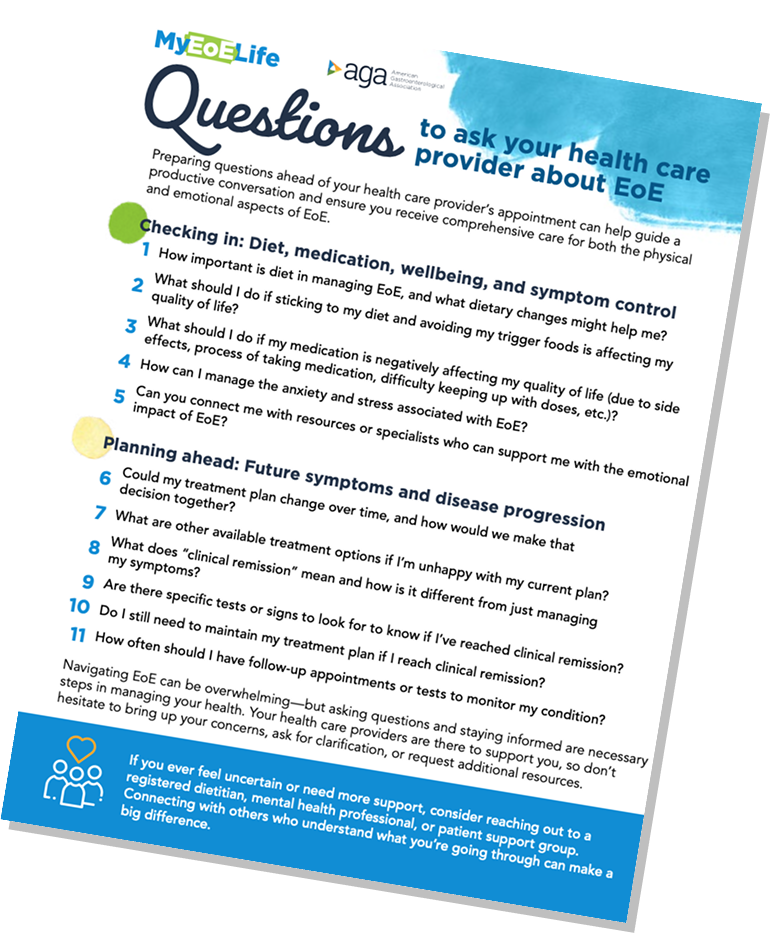The path to
remission

What does it mean to achieve & maintain remission for EoE?
Understanding the path to remission
EoE is a chronic and progressive condition, which means that it is long term and it can build over time. Even when symptoms ease, inflammation can remain active in the esophagus, often without obvious signs. That inflammation can cause lasting changes, including scarring and narrowing, which may lead to difficulty swallowing and other complications. But with treatment, EoE can be managed.
Remission is not just about feeling better. It means healing beneath the surface. Getting there takes regular check-ins potentially with endoscopies, a treatment plan that evolves with your needs, and a care team that helps you stay on track. Every step you take toward remission protects your health now and into the future.
Remission vs. symptom management
Improving symptoms can feel like a turning point, and in many ways, it is. But remission goes deeper than that. It’s when inflammation in the esophagus has been reduced and the esophagus appears healed, something your care team can see on endoscopy with biopsy to assess for scar tissue and measure eosinophils, the white blood cells involved in EoE.
Because symptoms and inflammation don’t always move at the same pace, your health care provider may suggest additional testing even when you’re feeling better. These check-ins are how you stay ahead of the condition and protect your health over time.
Ongoing check-ins: Why testing still matters
Managing EoE isn’t just about how you feel today. It’s also about what’s happening inside your body over time. That’s where ongoing check-ins come in. Regular testing helps your care team track inflammation and confirm whether your treatment is doing what it’s meant to do.
This often includes:
Endoscopy with biopsy, to examine your esophagus and collect tissue samples.
Follow-up visits, to check in on your progress and adjust your care as needed.
Unsedated transnasal endoscopies (uTNE), to monitor EoE symptoms.
Medical devices, such as EnteroTrack, to evaluate inflammation.
Staying in remission means staying proactive (even when you’re feeling okay).
There’s more than one way to treat EoE
EoE care works best when it’s built around you. Your provider will help you find a treatment plan that fits your symptoms, lifestyle, and goals—and that plan may change as your needs evolve.
There are two main treatment categories for EoE:
Dietary therapy, which involves identifying, removing, and strategically reintroducing specific foods that trigger inflammation.
Medications, such as swallowed corticosteroids, proton pump inhibitors (PPIs), or biologics. If you are using medication to manage your EoE, you may not need any dietary restrictions.
If your esophagus has narrowed due to persistent, untreated EoE, your health care provider may recommend an endoscopic dilation.
Treatment isn’t one size fits all. What works for someone else may not be right for you. The goal is to find an approach that helps you feel better and keeps your EoE under control over time.
How well are you managing your
EoE?
This short quiz is designed to help you reflect on your EoE management and spark conversations with your care team about your next steps.
Questions
to ask your health care provider
Achieving and staying in remission starts with staying informed, so it helps to have a plan and an open line of communication with your care team. Whether you’re working toward remission or trying to stay there, your questions can shape the care you receive. You can start with something simple, like:
“I’m feeling better, but I want to make sure we’re actually keeping my EoE and the inflammation under control. What should we be looking for next?”
We created a guide with key questions to help you talk with your health care provider about remission, treatment options, and how to monitor progress over time. It’s designed to help you feel more prepared and confident at your next appointment.

